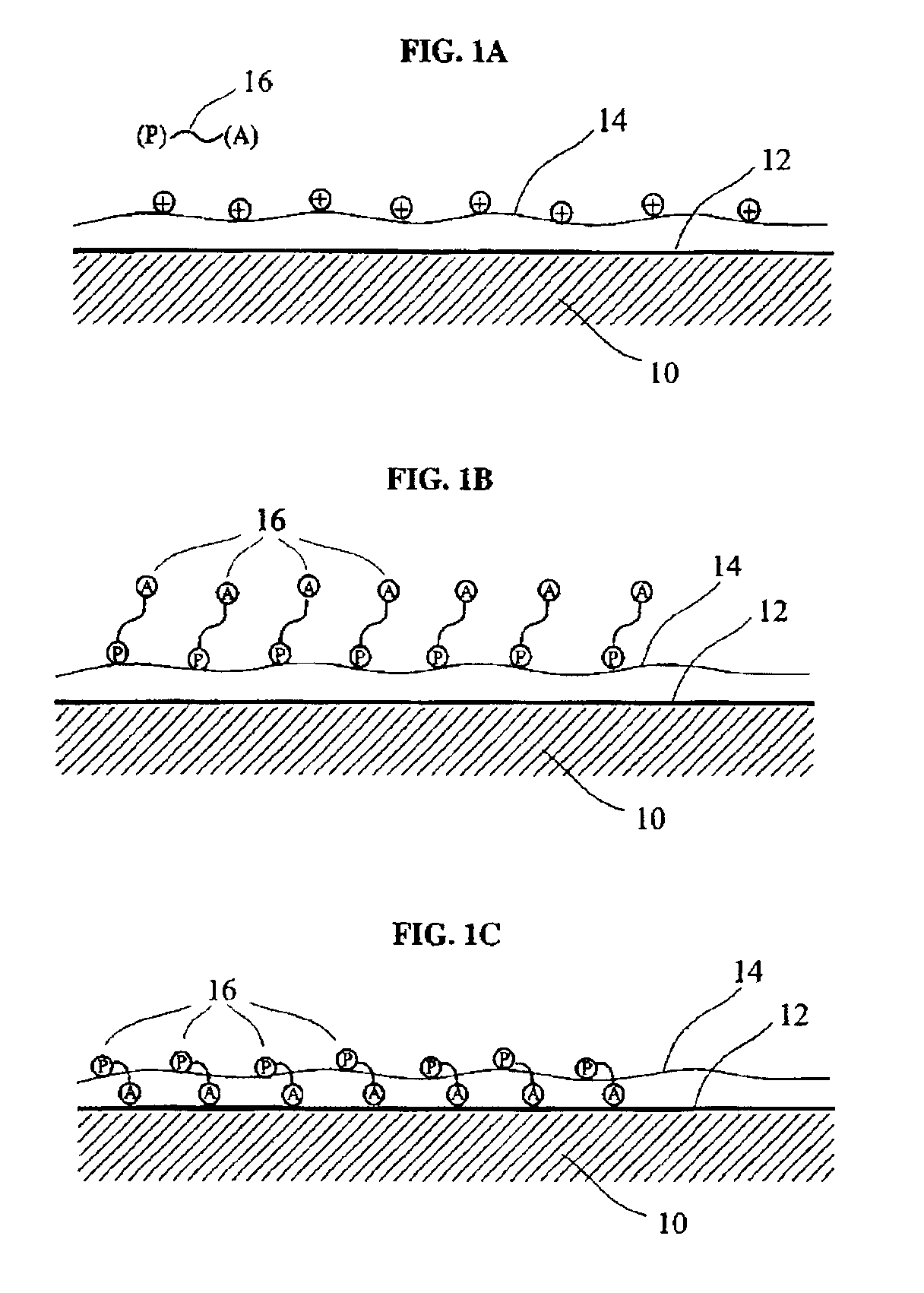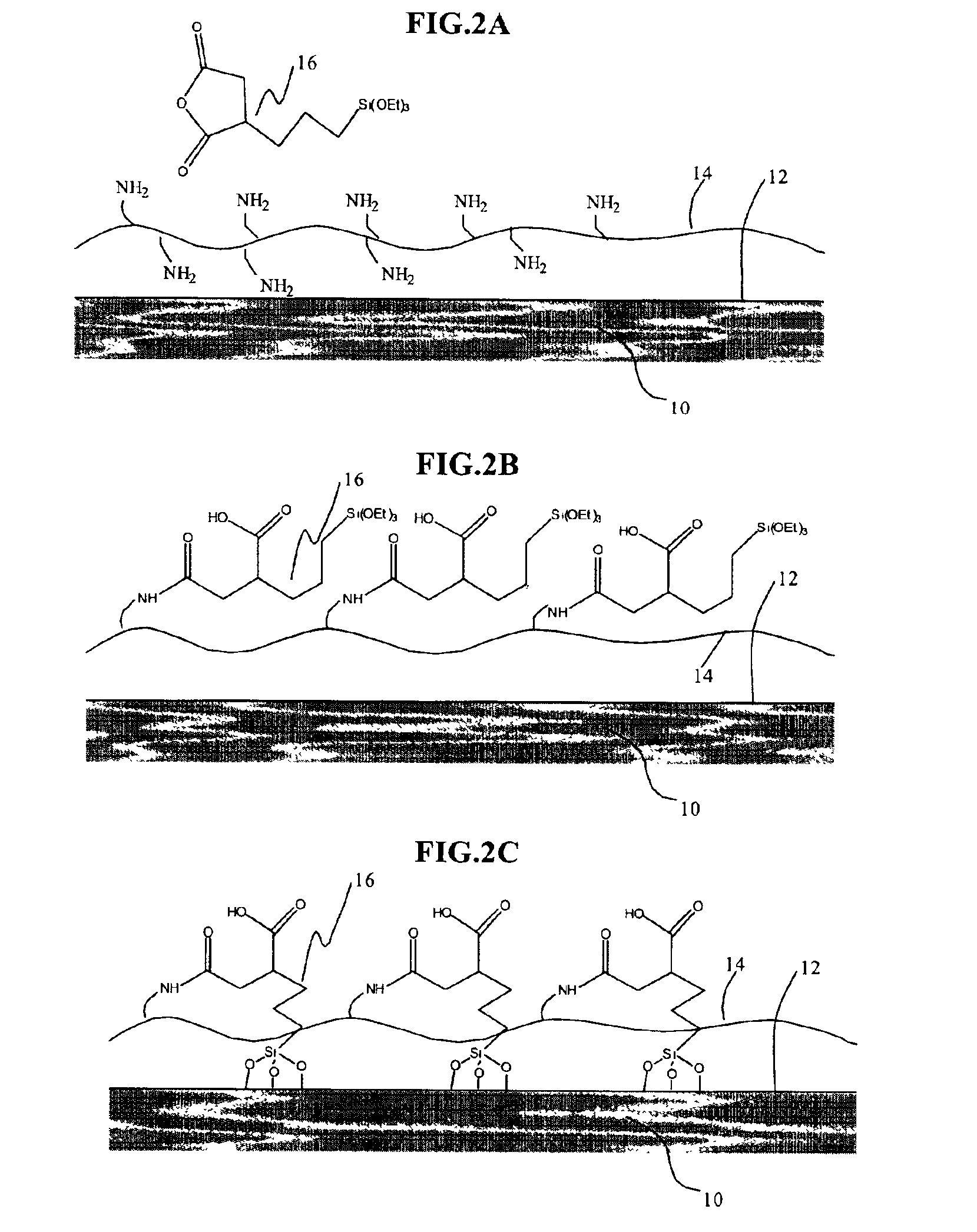Methods of making microarrays with substrate surfaces having covalently bound polyelectrolyte films
- Summary
- Abstract
- Description
- Claims
- Application Information
AI Technical Summary
Benefits of technology
Problems solved by technology
Method used
Image
Examples
example 1
Poly(L-lysine)-Coated Substrate
[0091]The Poly-L-Lysine Solution used in this example was purchased from Sigma Dianostics Inc. (Cat # P8920) and used as received. The glass slides were placed in 5% RBS solution, and were sonicated for approximately 15 minutes. They were then rinsed with running deionized water for approximately 5 minutes. The glass slides were transferred directly to a concentrated wash solution for approximately 15 minutes. They were then rinsed with running deionized water for approximately 10 minutes. The Poly-L-Lysine coating solution was prepared by adding 80 mL 0.1% w / v Poly-L-Lysine solution and 80 mL 1×PBS to 640 mL milli-Q water. The coating solution was made fresh before use and was stirred on a stir plate at room temperature. The slides were dripped briefly and were put into the Poly-L-Lysine coating solution for approximately 20 minutes, with gentle agitation. The slides were then rinsed with running DI water for approximately 5 minutes. The slide substra...
example 2
Preparation of Nucleic Acid Probe Spots on Poly(L-lysine)-Coated Substrate
[0092]cDNA spots were applied to a poly(L-lysine) coated surface of the substrate from Example 1 using either a pin spotter common in the art such as the SpotBot from TeleChem International, or “inkjet” spotters which are commercially available from Microfab Technologies. To accommodate densities beyond what off the shelf solutions provide customs systems can be manufactured by motivated investigators. The placement of the biomolecules and the density of the features in the resulting array is software controlled with computers. cDNA acid spots were dried and crosslinked at 450 or 1800 mJoules using a Stratalinker.
example 3
Treatment of Substrate Surface with Triethoxysilylpropyl Succinic Anhydride
[0093]The 3-(triethoxysilyl)propyl-succinic anhydride used in this example was purchased from (Gelest, Inc. Cat# SIT8192.6) and used as received. The substrate of Example 2 was immersed in 50 mM NaOH for approximately thirty seconds. The substrate was then immersed in a freshly made solution of 7.9 g 3-(triethoxysilyl)propyl-succinic anhydride dissolved in 139.3 mL 1-methyl-2-pyrrolidone and 10.7 mL of 1M Sodium Borate, pH 8.0 (pH approximately 8.0 per 158 mL) for approximately 30 minutes with stirring. The substrate was then washed for approximately 10 minutes in Milli-Q water, with stirring. It was then rinsed in ethanol for approximately 1 minute. After washing in the above manner, the slide substrate was dried with nitrogen gun and then baked in a convection oven in ambient air at approximately 80° centigrade for approximately 3 hours (which results in substrate shown in FIG. 4A), or approximately 17 hour...
PUM
| Property | Measurement | Unit |
|---|---|---|
| Volume | aaaaa | aaaaa |
Abstract
Description
Claims
Application Information
 Login to View More
Login to View More - R&D
- Intellectual Property
- Life Sciences
- Materials
- Tech Scout
- Unparalleled Data Quality
- Higher Quality Content
- 60% Fewer Hallucinations
Browse by: Latest US Patents, China's latest patents, Technical Efficacy Thesaurus, Application Domain, Technology Topic, Popular Technical Reports.
© 2025 PatSnap. All rights reserved.Legal|Privacy policy|Modern Slavery Act Transparency Statement|Sitemap|About US| Contact US: help@patsnap.com



